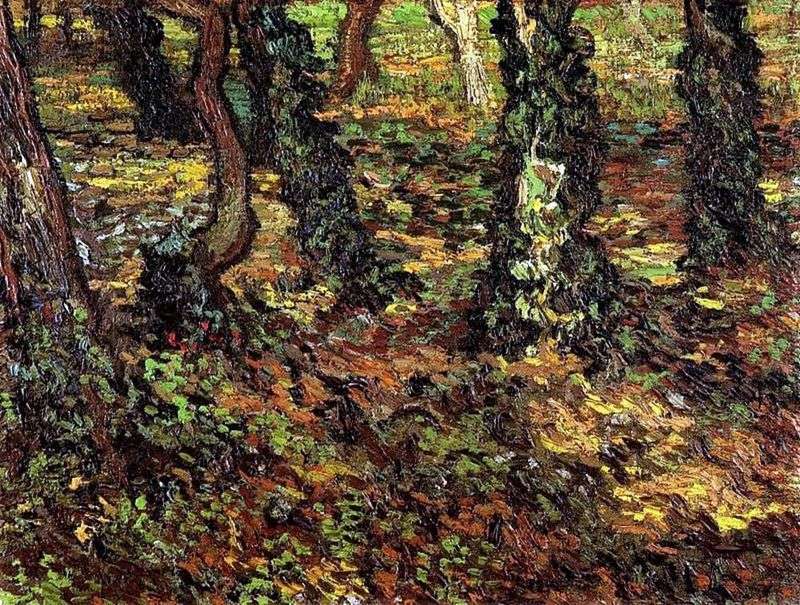
Van Gogh in his last years of creativity has written 18 landscapes of olive trees. Forever remain enigmatic creative process of a great artist in this dramatic and difficult period of his life. One can only assume that his restless soul, finds peace and relaxation, where he worked on these landscapes.
Mediterranean rich in its cultural and artistic traditions.
The olive tree, generously feeding the fruits of their many generations of people, of course, is an integral part of the culture and way of life of all peoples living there long. Oliva has a unique noble beauty, which for centuries has inspired poets and artists. Her appearance there is something mystical and unusual sculpture – the natural structure of a powerful, intricately convoluted bore, contrasting with the silvery foliage grace permeated the southern sun.
The artist post-impressionist Vincent Van Gogh, while living in France, has written numerous landscapes in which olive tree is well recognizable and the second plan of his paintings: Olive growing in the midst of ripe wheat, close to a large and dark cypress trees – “Wheatfield with cypresses “. Olive groves are clearly visible on the hilly expanse of his most famous painting “Starry Night”, written shortly before his tragic death and filled with deep philosophical sense of the finiteness of human life and radiant infinity of the cosmos.
The great Dutch artist, when his life was not understood by his contemporaries. The closest person who understands his soul and subtle mental dispensation, was the brother Theo for him. Only he could confidently tell Vincent about his creative plans and experiences, always finding a hearty response, and receiving from him all possible support, brotherly love and caring.
Brother was his only consolation in the difficult period when he voluntarily went to the treatment of mental disorder to a hospital in Saint-Remy. Theo hoped for a speedy recovery and continue to inspire his brother Van Gogh his sincere belief in his talent. While working on a series of landscapes with olive trees under different lighting condition, depending on weather and time of day, Vincent wrote Theo these words: “I am looking for contrasts in the leaves that change color tone of the sky”.
The olive tree has been for Van Gogh’s great spiritual significance, especially given the fact that he, having been born in the family of a Dutch priest, a Protestant, he received a religious education and knew the Bible. His delicate and sensitive soul, from childhood was taught to love and compassion, and rich artistic imagination carries him in the “Garden of Gethsemane” where olive trees grow on the ancient stony ground, waiting for the heavenly life-giving water.
Therefore, the case was not of such great interest to the olive, and his series of olive trees – defined characters. This is just a guess, but in one of his letters to his brother Theo, Vincent Van Gogh, listing your favorite pictures, names landscape with olive trees and the blue mountains in the distance. The attraction to this mystical tree was irresistible, and imprinting on his canvases Olivier Van Gogh expressed his the inspired creativity of the special and deeply personal relationship to the revered in many cultures the olive tree – a symbol of life, Peace, Wisdom and Happiness.
The artist was enchanted by the magical interplay of the tree branches, and the changing foliage in the sunlight shades. Van Gogh reflected in his collection “Olivier” a new way of painting for him, where he adds a long, wavy strokes. It is said that it was the result of his mental state during this period. But the picture is still beautiful!
 Olive trees by Vincent Van Gogh
Olive trees by Vincent Van Gogh Trees by Vincent Van Gogh
Trees by Vincent Van Gogh Olive Grove IV by Vincent Van Gogh
Olive Grove IV by Vincent Van Gogh Trunks of trees with ivy by Vincent Van Gogh
Trunks of trees with ivy by Vincent Van Gogh View of Arles among flowering trees by Vincent Van Gogh
View of Arles among flowering trees by Vincent Van Gogh Street with plane trees near Arley station by Vincent Van Gogh
Street with plane trees near Arley station by Vincent Van Gogh Parish Priest’s House in Nyuenen by Vincent Van Gogh
Parish Priest’s House in Nyuenen by Vincent Van Gogh Olive grove: the orange sky by Vincent Van Gogh
Olive grove: the orange sky by Vincent Van Gogh